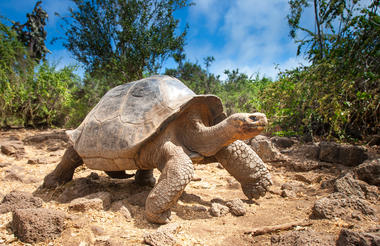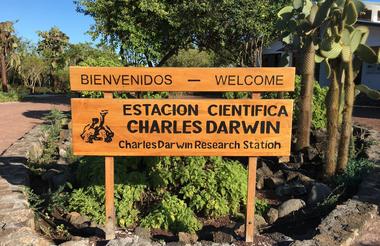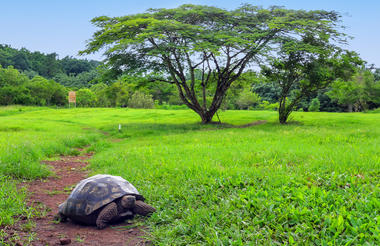Departure to the Galapagos Islands, arrival at Baltra airport, where our naturalist guide of the National Park will be waiting for you.
Bachas gets its name from the remains of two large barges (mispronounced by locals as “bachas”) left by the Americans during WWII. At low tide you can still see the iron skeletons of the barges buried in the white sand. From November till May, this place is also one of the most important sea turtle nesting grounds in the entire Galapagos islands. There are also several small saltwater lagoons where we often see flamingoes, herons and other aquatic birds.
Snorkel: After the walk, you will have the option to swim or snorkel from the beach. The area is rich in some of the most common fish species of the Galapagos, but you can also find white-tipped reef sharks and rays.



Lunch
Dinner
In the morning you visit Sullivan Bay. This hike is a journey into understanding the birth of these volcanic islands. You will walk in a very well preserved flow of Pahoehoe lava, which will give you endless opportunities to see the delicate textures of these type of lavas which only appear in a few places throughout the world. At first sight the barren landscape looks completely deprived of life, but look carefully for pioneer plants, lava lizards and small birds. By the shore, you can find penguins, pelicans and oystercatchers.
Snorkel: You will have the option to swim or snorkel from a coral sand beach or from the dinghies. Getting underwater is like traveling to another world: if the land is almost lifeless, the sea is teaming with life, including large schools offish, Galapagos penguins, reef sharks, turtles and rays.
In their afternoon you will visit La Rabida. Rábida is a small island famous for its reddish lava rocks (rich in iron) which gives it a unique look. The beach is also red and hosts a small colony of sea lions. There is a small salt water lagoon where we will see ducks and stiltsand sometimes flamingoes. The trail will take you inland to get beautiful views of the beach and the lagoon. Look forDarwin finches, flycatchers and mockingbirds. In the cliffs along the coast you can find Nazca & blue-footed boobies, brown noddy, herons and the two species of sea lions: Galapagos and fur seals.
Snorkel: You can snorkel from the beach and explore a sheltered rocky area, which is excellent for fish, sea lions and reef sharks. Look at the high diversity of small invertebrates attached to the vertical walls.



Breakfast
Lunch
Dinner
In the morning, you will visit Punta Espinoza. Located at the base of an imposing volcano (the most active in the Galapagos islands) this site is one of the jewelsof the Galapagos National Park. As soon as you disembark you will be surrounded by hundreds of marine iguanas, as this is the largest colony for the species. Sea lions bask in the beaches while their pups play in tide pools. Along the shore you will see flightless cormorants, which are restricted to the western areas of the archipelago. Surrounded by cold plankton-rich waters, Punta Espinosa is home for an array of species, including herons, pelicans, oystercatchers, sea turtles, shorebird and many more. Look up in the mangroves as Galapagos hawksoften perch to look for their prey.
Snorkel: The nutrient-rich waters around Punta Espinosa attracts great numbers and diversity of fish and sea turtles.Seaweeds are also abundant, making this place the best for seeing marine iguanas feeding underwater. Following a cormorant underwater as it chases fish through the reef is one on the most amazing snorkel experiences you mayhave on your trip.
In the afternoon your visit goes to Tagus Cove. Tagus cove is one of the places Charles Darwin visited during his exploration of the Galapagos islands. A trail will take you through a dry Palo Santo forests where you can see Darwin finches and mockingbirds. You will get greatviews of Darwin’s lake and the large volcanos of northern Isabela.
A boat tour along the shore will give you chances to see penguins, cormorants, marine iguanas and a very uniquespecies: the Galapagos martin, a small endemic bird which is one of the most endangered species on the island.
Snorkel: The nutrient-rich waters around Tagus Cove attracts a lot of sea turtles and a great diversity of fish, but also penguins, who feast on large schools of anchovies. It is common to see cormorants underwater as they chase fish through the reef.



Breakfast
Lunch
Dinner
Urbina Bay is visited in the morning. This place is known for the dramatic uplifting that happened here during the 1950’s. A large portion of the coast waspushed up, exposing many hectares of previously submerged land. Look carefully along the trail and you will findsmall shells and corals, a proof that the area was underwater more than sixty years ago. The trail will give the opportunity to see land iguanas and, during certain seasons, giant tortoises. Galapagos hawks nest in the area andare often seen flying or perched on the trees.
Snorkel: You can snorkel from the beach to see sea turtles, cormorants and penguins. Fish are also abundant in the area.
Elizabeth Bay is a beautiful sheltered bay surrounded by large mangroves and barren lava fields. There is no trail here so you will take a dinghy tour to explore many channels, pools and coves teeming with life. This is one of the best locations in the islands to see Galapagos penguins, but don’t expect to see thousands of them, as the entire population of the islands is only about 3.000 of them. Flightless cormorants also nest in the area and blue-footed boobies and pelicans often fish in these shallow and rich waters. Rays and sea turtles are also very abundant.



Breakfast
Lunch
Dinner
Located very close to Puerto Villamil, the main town in Isabela, the small islet of Tintoreras is surprisingly rich in wildlife. There are extensive colonies of marine iguanas and sea lions and you will see rays and sea turtles in the shallow channels. Here it’s easy to see reef sharks, locally known as “Tintoreras”. Herons and gulls are also common and if you are lucky, you might see a Galapagos penguin, as there are a few individuals in the area.
The wetlands of Villamil include a large area of lagoons, channels and coves located near the town. The salt water lagoons are surrounded by mangroves and are rich in bird species, sheltering species such as American flamingo, white-cheeked pintails, gallinules, stilts, herons and other shorebirds. The main trail starts at the town and ends at the Tortoise Breeding Center



Breakfast
Lunch
Dinner
Floreana is famous for the tales of German settlers and the baroness during the late 1920’s and 30 ‘s.Assassinations, disappearances and other unsolved mysteries are the ingredients of this fascinating story. Post office bay was often used by whalers to anchor their ships and go up to the highlands to get freshwater and tortoises. Most boats visiting the Galapagos had to came to this place sooner or later, so a system of mail was established more than 200 years ago: a barrel near the beach became the way to leave messages to other ships and also to the outside world. This mail system is still in use and will allow you to send postcards from the Galapagos to the outside world. Aside from a small beautiful beach and a lava tunnel, the area is great for dinghy tours to look for sea lions, green sea turtles, shorebirds, small sharks and, with some luck, Galapagos penguins.
Punta Cormorant is located in the north of Floreana and it is known for its large coastal lagoon with Americanflamingoes, white-cheeked pintails, black-necked stilts and other shorebirds. There is a beautiful white sand beachwhich is an important nesting ground for green sea turtles where we can also see rays and reef sharks. In the last years, a small groups of blue footed boobies have started to breed right by the trail. This is also a great trail to look at endemic plants.



Breakfast
Lunch
Dinner
Either if you do this visit starting from Baltra or from Puerto Ayora, a bus will take you to the highlands stopping along the way at one of the reserves to visit the lush highland forests where you will look for Galapagos Giant tortoises in their natural environment. This is the best place in the Galapagos to see these gentle giants (reaching over 300 kg / 600 pounds!) casually grazing and resting in freshwater ponds. This is also home for a great diversity of birds rarely found at the lowlands, including finches (tree, woodpecker and vegetarian finches), flycatchers and several species of water birds. You will visit a lava tunnel (depend on the itinerary) and learn how these extraordinary formations were created by ancient volcanic eruptions.
The Charles Darwin Station is a nonprofit organization which has been working for decades together with theGalapagos National Park to preserve the biodiversity of these unique islands. During this visit you will learn about the projects that both institutions carry together to protect the native species and eradicate the invasive ones which are threatening the Galapagos environment. One of the most important and emblematic projects has been reproducing giant tortoises in captivity. The visit is mostly outdoors in a beautiful dry native forest with giant cactus and manyother interesting native plants. It is also a fantastic place to find several endemic Darwin finches, as well asflycatchers and mockingbirds.



Breakfast
Lunch
Dinner
North Seymour island is home for large colonies of both magnificent and great frigatebirds and you can see them displaying their red balloons to attract a female. Blue-footed boobies nest in the ground and perform their famous dance in the open areas, while swallow-tailed gulls perch on the cliff edges. Land iguanas are common inland while their marine cousins bask in the rocks by the sea, close to sea lions, which often like tobody surf in the waves.



Breakfast





